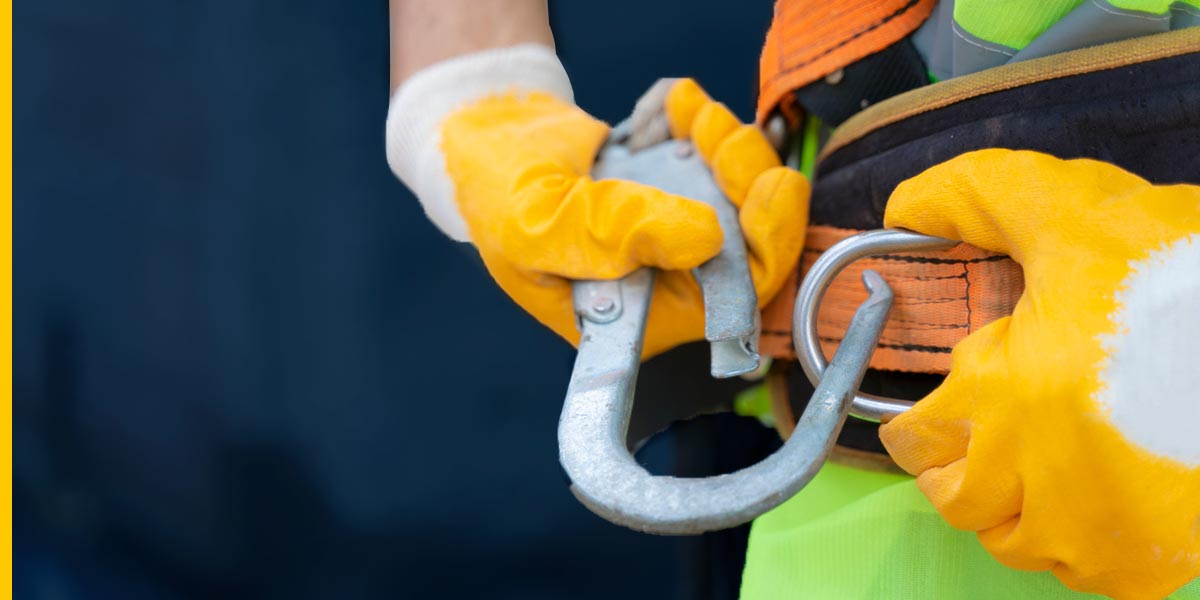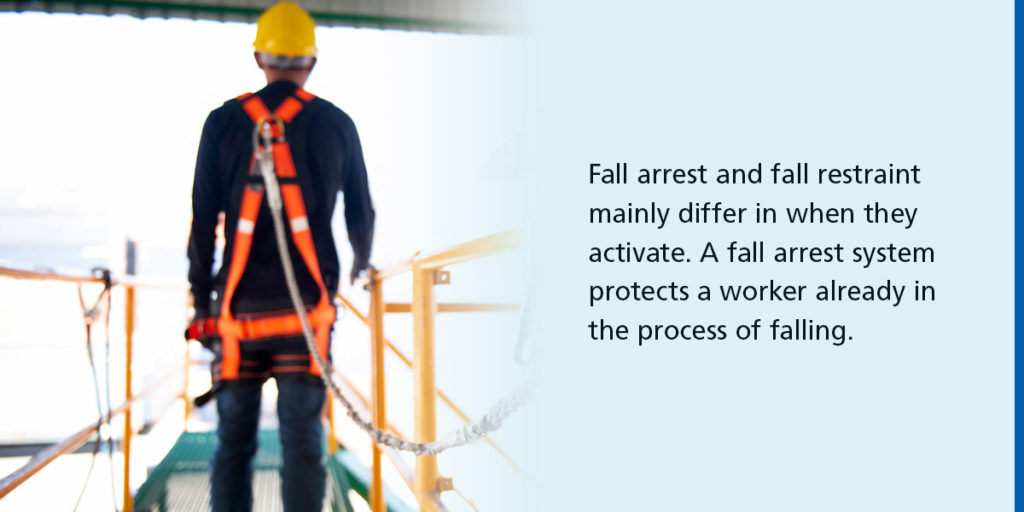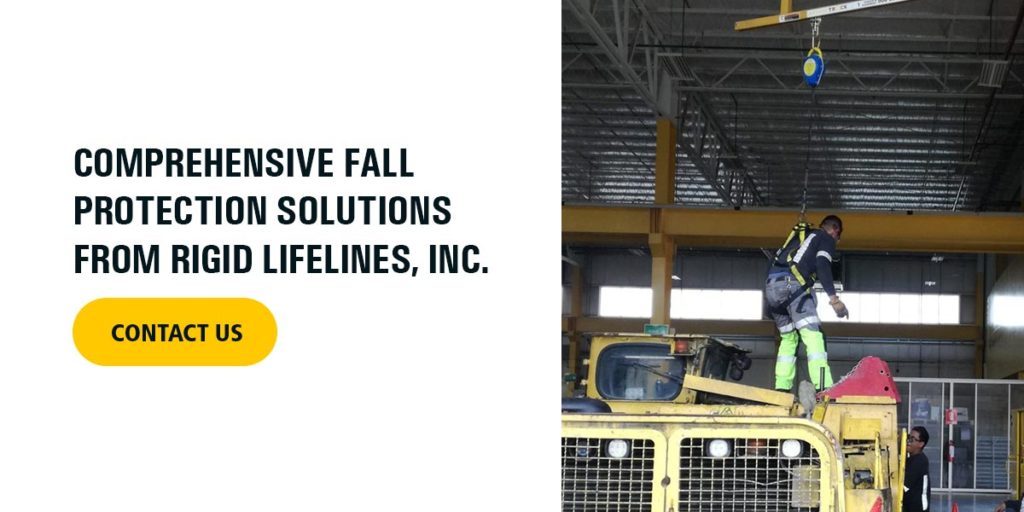
Fall Arrest vs. Fall Restraint: Which One Is Better?
December 21, 2012
Though many people lump them together, fall arrest and fall restraint are two distinct systems, and using the wrong one for a job could have disastrous consequences. If you find yourself needing to choose between one or the other, you may wonder what the difference is.
These two options primarily differ in how and when they protect workers from injury or death from a fall. Since the leading cause of death in construction is falls, the proper protection system is critical. Each has unique demands and limitations, so you’ll need to understand this distinction to best protect your employees and stay compliant with safety regulations. Let’s take a closer look at fall arrest and fall restraint systems and how you can pick the correct one for your workers.
Fall Arrest Systems
A fall arrest system protects workers by activating after a person falls from a height, and there are many types of fall arrest systems to fit various configurations and layouts. General fall arrest systems apply to multiple users and might include nets or catch platforms. Personal fall arrest systems are designed for individuals and are comprised of several types of personal protective equipment.
The components of a personal fall arrest system include the following.
- Full-body harness: A full-body harness securely attaches the worker to the other components to stop a fall quickly and minimize injury to the wearer. The straps distribute the forces of a fall across the body.
- Anchorage point: This attachment point is specifically for holding lifelines, lanyards, and deceleration devices. They come in several designs, including temporary and permanent options.
- Connecting Device: The connecting device connects the user’s full-body harness to the anchorage point. There are multiple types of connecting devices designed to slow a falling worker and reduce the arresting force.
- Shock-absorbing lanyard: A shock-absorbing lanyard, also known as an energy-absorbing lanyard, is a connecting device that creates a connection between the harness and an anchor point. Shock absorbers help minimize the forces of a fall.
- Self-retracting lifeline: A self-retracting lifelines is a connecting device that works similarly to a seatbelt in a car. It moves and retracts responsively, engaging a quick braking mechanism if the line is pulled out rapidly. The line can move freely again once the tension is released.
- Locking connectors: Connectors might include elements like carabiners or D-rings that link multiple components of the personal fall arrest system together. They must lock in place to avoid unclipping.
How Are Fall Arrest Systems Used?
Workers should use a fall arrest system whenever it isn’t possible to reach an area without creating a fall hazard. For example, guardrails might prevent a worker from accessing an area that needs attention. A fall arrest system would allow them to access locations where guardrails can’t be used while maintaining fall protection.
According to OSHA guidelines, fall arrest systems are necessary whenever employees enter fall risk zones. Regular inspections ensure safety.

Fall Restraint Systems
A fall restraint system, also known as a tie-off system, prevents a worker from accessing a fall hazard in the first place. For example, employees working on a roof might secure themselves to a line that doesn’t extend past the edge, so there’s no space for them to fall.
Here are some examples of fall restraint systems.
- Guardrails: Guardrails create physical barriers between a worker and a fall hazard. You’ll see them in areas like rooftops and staircases.
- Walkways: Walkways, typically combined with guardrails, provide slip-resistant surfaces for moving safely at heights.
- Restraint lines: Restraint lines tether the worker to an anchorage point to prevent movement outside of a specified range.
Fall Restraint Systems vs. Personal Arrest Systems
Fall arrest and fall restraint mainly differ in when they activate. A fall arrest system protects a worker already in the process of falling. It does this by stopping the fall after it has occurred. A system provides fall restraint by preventing the worker from accessing the potential hazard.
Fall arrest is most beneficial in specific circumstances, including allowing workers to access more locations on a site. Sometimes, hard-to-reach locations cannot accommodate fall restraint equipment. Though accessing these locations can be dangerous, it’s sometimes essential for a worker to reach these areas. In these circumstances, fall arrest equipment may be the only viable option to protect workers from fall hazards.
Fall restraint and fall arrest systems can include passive or active fall protection.
- Active fall protection: Active systems rely on participation from the user and have movable parts and specialized components. For example, a PFAS requires the worker to wear a harness and use lanyards, anchors, and various connectors for full protection. Fall restraint systems can also be active, such as static restraint lines that require the user to attach themselves to an anchorage point.
- Passive fall protection: These systems do not require individual PPE such as harnesses. Workers can use them for fall arrest, such as netting, or for fall restraint, such as guardrails and walkways.
Combining these two options is often necessary to create comprehensive protection on a work site. Passive systems can be helpful because they don’t usually require special knowledge of how to use the system. Guardrails and nets provide reliable stopping power. On the other hand, active systems like PFAS require the user to know how to set everything up and inspect the equipment for safety issues, such as a torn lanyard.
Fall arrest and fall restraint systems require thorough training to offer adequate protection. Education is a critical element of any fall protection system because it gives workers an in-depth perspective on using the tools provided. It also helps them know what to expect, prepare for, and use their PPE correctly. Even installers need appropriate training to ensure they understand how to set up these lifesaving tools appropriately.
For any fall protection system to work, employees must wear PPE properly and be aware of the hazards.

Comprehensive Fall Protection Solutions From Rigid Lifelines, Inc.
At Rigid Lifelines, Inc., we know fall arrest and fall restraint systems are crucial. Depending on your situation, we’ll help you find the right solution for your project and employees. We offer a wide range of fall protection solutions, including permanent and mobile track systems and fall protection components. We aim to simplify worker safety and make compliance easy through reliable, user-friendly solutions for virtually any job site.
Whether you need a specific piece of equipment for a facility or something flexible that can adjust to diverse work sites, Rigid Lifelines has the expertise and quality products to help. Explore our solutions online, or reach out to a representative today to discuss the right fall protection system for your application!
Categories
Share this post
Let us help you
Contact us today to find the perfect product fit for your job

